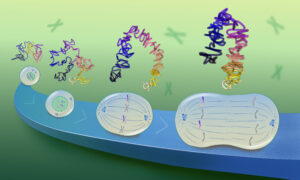
How structural biology helps to make RNA vaccines
EMBL Hamburg’s expertise in small-angle X-ray scattering helps to develop new RNA vaccines
RNA vaccines, such as the ones for COVID-19, represent a new approach in vaccine technology. They contain messenger RNA (mRNA), an instruction-carrying molecule that tells a cell to make a specific protein. To ensure RNA is delivered to human cells, RNA molecules are placed inside little droplets of fat, called lipid nanoparticles, which protect them. Cells take up the RNA and start to produce the pathogen’s protein. This lasts only for a short time because the RNA is soon degraded. The RNA and its resulting protein do not make a person ill but are sufficient to train the immune system to recognise and destroy the pathogen. Interestingly, this method can be used to gain immunity not only to bacterial and viral infections but also to certain types of cancer.
Cy Jeffries, faculty staff scientist at EMBL Hamburg, explains the clever technology behind RNA vaccines and how structural biology contributes to its development. He and his colleagues in the Svergun Group specialise in a method called small-angle X-ray scattering (SAXS), which allows them to study the molecular structure of particles directly in solution. Using SAXS, they are able to monitor the shape of lipid nanoparticles in different conditions to make sure they are effective in protecting the RNA and release it only upon entering human cells.
The Svergun Group collaborated on several projects focusing on lipid nanoparticles used for RNA vaccines. Among others, BioNTech, the biotech company that together with Pfizer released one of the first COVID-19 vaccines, conducted studies on how RNA can be better packaged and delivered into human cells using the EMBL Hamburg’s beamline P12. The results of their research are available in several publications, published together with Johannes Gutenberg University Mainz, Tel Aviv University, Leiden University, and Forschungszentrum Jülich.
EMBL’s scientific services provide users with access to innovative technologies and high-quality instrumentation, in combination with the scientific and technical expertise of our staff. Providing scientists in academia and industry with access to the latest scientific technologies, infrastructures, and data resources is one of the core EMBL missions.


